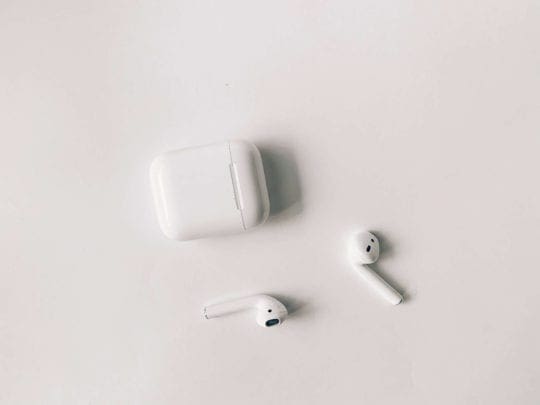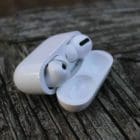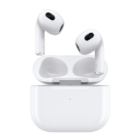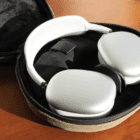It’s been nearly five years since the first pair of AirPods, the predecessor to AirPods Pro and AirPods Max, was launched. For the first year, the earbuds were mocked all across the internet, being compared to overpriced q-tips.
I remember these comments well because I was one of the first buyers and defenders of AirPods. And it looks like I ended up on the right side of history because AirPods has become one of Apple’s most iconic and successful products since the iPhone.
Today, three headphones fall under the AirPods branding, each with different features and form factors. In this post, I’m going to break down each of these types of AirPods, how they’re similar, how they’re different, and clue you in on which to buy.
Let’s get into it.
Contents
AirPods, AirPods Pro, and AirPods Max: What are they?
First, let’s separate each type of AirPods. If you already know what each pair is, you can skip down to How AirPods, AirPods Pro, and AirPods Max compare for a deeper dive into the features of each.
For now, let’s just look at what each pair is.
AirPods: Apple’s wireless hit
AirPods are Apple’s most basic wireless headphone option. That said, these things are far from basic. They’re still well above budget-friendly, starting at $159 a pop. These wireless earbuds are truly wireless, meaning there isn’t a cable connecting the two earbuds.
Each bud operates independently of and cooperatively with the other. This means that you can use either AirPod on its own or use two in tandem. AirPods have decent sound quality (comparable to Apple’s wired EarPods) and are easy to use. The design resembles EarPods that have had the wires cut off.
And that’s about all there is to cover! These are very simple wireless earbuds that are known for being incredibly reliable and easy to use.
AirPods Pro: The pricey AirPods alternative
The AirPods Pro earbuds were released in 2019, making them a recent product from Apple. They’re more expensive, starting at $249, and include multiple features that aren’t available on standard AirPods. This includes active noise cancellation, transparency listening, extra buttons, and so on.

AirPods Pro are smaller as well. They almost fit completely in the ear, with a small stem that acts as a microphone and center for controls. These AirPods have a soft gel tip as well, making them more comfortable for most users than the regular AirPods.
AirPods Pro are normally a go-to for those who want a flashier pair of AirPods and/or noise cancellation. The audio quality is slightly improved as well, putting these more in line with Bose headphones.
AirPods Max: Apple’s latest over-ear headphones
That brings us to AirPods Max, the latest in the AirPods lineup. These headphones use the AirPods branding, however, I don’t think they’re nearly as comparable as the standards and the Pros.
AirPods Max are an over-ear set of headphones with big ear cups and a mesh rest for the top of your head. They’re wireless, though you can connect them to a device with a USB C wire. There isn’t a 3.5mm headphone jack, however.
These are much pricier than the others, priced at $549, and have a much higher level of audio fidelity. There’s some debate on how much of an improvement in audio these present, which we’ll get into, but suffice to say that these are the “big boys” of Apple’s AirPods line.
How AirPods, AirPods Pro, and AirPods Max compare
Ok, so now that we’ve covered the basics of each pair of AirPods, let’s get into how they compare on specific features and price points.
Bear in mind that AirPods Max is likely going to outperform the other two in every category. So we aren’t just going to say “AirPods Max are the best” seven times in a row.
Instead, I’ll be comparing them using their price, competitors, and audience. That way you get a more realistic idea of how they perform in their respective niches.
Price
We’ve already touched on the prices for each, but here they are again for comparison:
- AirPods: $159 (wired case); $199 (wireless case)
- AirPods Pro: $249
- AirPods Max: $549
The AirPods and AirPods Pro are competitors, while AirPods Max is in its own league. The price is primarily a reflection of the increase in audio quality, as well as the addition of noise cancellation.
In my opinion, each line of AirPods is starting at far too high a price. If the lifespan of the AirPods and AirPods Pro was longer, then I think they’d be a bit more justifiable.
For now, none of these has a very affordable price. It primarily comes down to what you’re able to afford and how much you’re willing to give for improved audio quality.
Features
The standard AirPods are pretty barebones when it comes to feature. You can double-tap each to activate a custom action (play/pause, skip forward/backward, activate Siri, etc.). And that’s about it.

AirPods Pro has the same tapping feature, as well as Active Noise Cancellation and Transparency Mode. Active Noise Cancellation uses an outward-facing microphone to listen to your environment and counteract incoming sounds in real-time. This lets you listen to your content without interruption.
If you want to be interrupted, however, you can by using Transparency Mode. This uses the outward-facing microphone to bring outside noises to your ears while your content is playing. So if someone tries to talk to you while listening to music, you’ll be able to hear them and your music at the same time.
AirPods Max come with Active Noise Cancellation and Transparency mode as well that’s at least as robust as the AirPods Pro. It includes Spatial Audio as well, which makes it sound as if the audio you’re listening to is happening around you rather than in your ears.
In short: AirPods have little to no features, while AirPods Pro and Max have comparable features.
Sound quality
As mentioned before, AirPods have decent audio quality. While audiophiles might kick AirPods’s sound quality, the truth is that the average listener won’t notice any issues. It’s clear, clean, and captures music as you most often hear it. For the price, it would be nice to have a more competitive sound, but AirPods at least gets the job done.
AirPods Pro have a far improved sound. According to u/Degru on Reddit, it handles bass well without letting it become overpowering. Treble and mids are more neutral, presenting a clear, crisp sound, if not an exciting sound. In other words, AirPods Pro are much more competitive for their price range, though not the best in their price range. It’s the features that shine, though the audio is certainly there.
Lastly, we have the AirPods Max, which have received the most controversy when it comes to sound quality. That’s because, based on the pricing, style of headphones, and marketing, these should be approaching professional studio levels of quality.
From what I (a non-audiophile) can gather, AirPods Max offers crisp bass and great treble and mids for the price, although the treble is sometimes sharp and the bass occasionally bleeds. They have a sound that compares to over-ear headphones in the $350 range.
Comfort
When it comes to comfort, the standard AirPods are the most divisive. Some say they get earaches from wearing AirPods, while others can’t even get them to fit in their ears. I, however, have never had this problem nor known anyone who has. I’ve been able to wear mine for nearly all day and never even notice they’re there. I would try Apple’s wired EarPods for comparison since the shape is identical.

AirPods Pro improve on the AirPods comfort by adding a gel tip. This tip, which comes in different sizes, is said to be much more comfortable since all of the contact points with your ear are soft. In other words, the vast majority of users can wear them daily without issue, not just a few who find them comfortable.
Despite the focus on comfort, AirPods Max are less comfortable than AirPods Pro. However, that’s not because they’re poorly designed. Over-ear headphones are heavy and tight on the ears and will start to cause pains for anyone after a few hours. Compared to other over-ear headphones, though, AirPods Max are fairly comfortable. The top mesh rarely causes issues, though the ear cups do hurt after a bit.
Design
While AirPods were deemed ugly upon launch, I think most people have come around them. Needless to say, the look is iconic. They look almost exactly like a typical pair of wired Apple EarPods, only wireless. I think they’re sleek, simple, and suitable.
The AirPods Pro are probably my least favorite design. They’re smaller than AirPods, with a tiny stem sticking out of the ear, and an oblong white pod that sits in the ear. While not the sleekest design, they’re not as visible as the AirPods, so the design is less important here.
AirPods Max probably have the best design of the three. They look minimal and clean, come in multiple colors, and refine the classic over-ear design without looking off.
In short: None has a mind-blowing design. Each is perfectly passable, embracing simplicity in a becoming way.
Battery life
Something that each set of AirPods has done well is the battery life. I think if this hadn’t been done properly, they wouldn’t be nearly as popular as they are today.
The AirPods offer five hours of listening time on a single charge and twenty-four hours when paired with a charging case. Any time you aren’t wearing them, these buds are charging, so you never really notice the battery life. I’d give them a 10 out of 10.
AirPods Pro have similar battery life. Around four and a half hours with Active Noise Cancellation or Transparency Mode enabled, and twenty-four hours with the case. Again, 10 out of 10.
The AirPods Max surprisingly knock the other two out of the water. You can get up to twenty hours out of a single charge (that means without putting it back in a case or on a cable). That includes using features like Spatial Audio, Active Noise Cancellation, and Transparency Mode. However, these have to be charged with a Lightning cable, so they’re not as easy to charge on-the-go.
Sweat resistance
Last but not least, we have sweat resistance. If you like to exercise while listening to music, this is likely important to you, as moisture can damage headphones.
The standard AirPods are not water or sweat resistant. They don’t have any kind of IP certification. This means that typical sweat throughout the day probably won’t affect them, but intense sweating from exercise could damage them over time.
The AirPods Pro, on the other hand, do have some sweat and water resistance. Remember, though, that this doesn’t mean they’re waterproof. You can’t take them swimming or in the shower. After a sweaty workout or a bit of rain, dry them off before putting them back in the case.
None of the cases for AirPods, AirPods Pro, or Airpods Max have any kind of water or sweat resistance. The AirPods Max do not feature any kind of moisture resistance either.

Should I buy AirPods, AirPods Pro, or AirPods Max?
Here are my summarized thoughts on who should buy each version of AirPods:
- If $159 sounds like a big commitment, stick to Apple’s wired EarPods. The sound quality is the same, and it’s not worth breaking the bank of a BlueTooth pair of headphones you can easily substitute with a $30 pair of wired earbuds.
- If $159 sounds fine and you don’t know anything about audio fidelity nor care about noise cancellation, stick with AirPods. They’re semi-affordable and will give you everything you want.
- If you want noise cancellation as well as transparency mode, or if you don’t find standard AirPods comfortable, then you might consider shelling out the extra $50 for AirPods Pro.
- If you’re someone who listens to audio for a living, such as a video editor, then the AirPods Max are a pretty solid buy. They’re also a good buy for Apple fans who want to listen to music in high-fidelity. If you’re a musician, however, you can probably find a better alternative for less.
And that, I believe, is everything you need to know about AirPods in 2021. Thanks for stopping by!










Write a Comment